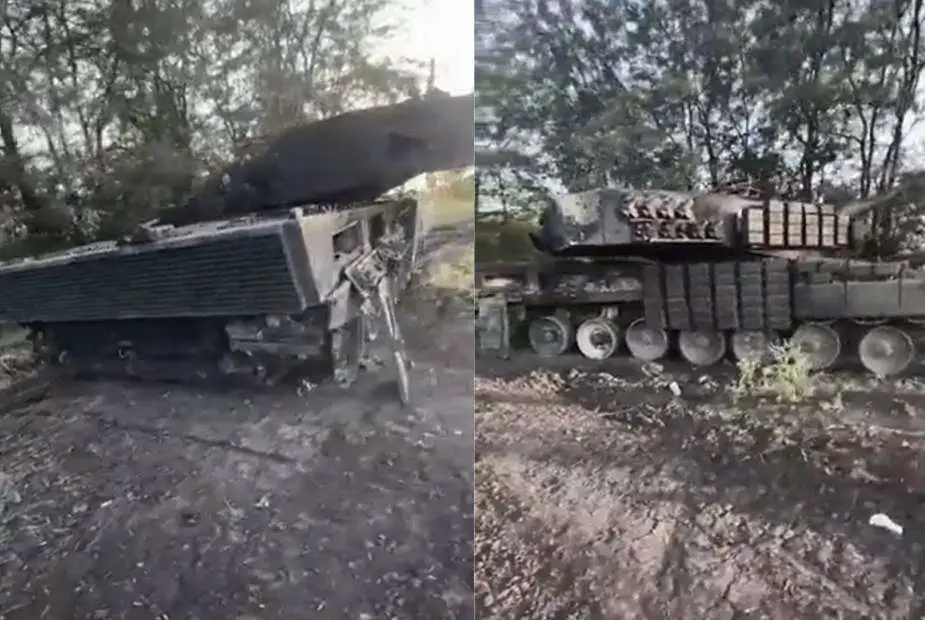- Army
- Conflicts in the world
- Israel - Iran conflict 2025
- Pakistan - India Conflict 2025
- Russia Ukraine War 2022
- Libya conflict day by day
- HAMAS - Israel War 2023
- Operation Serval in Mali French Army
- Sangaris operation Central African Republic
- Sangaris opération militaire République Centreafrique
- Ukraine - Russia conflict
- Syria conflict news
- Defence & Security Industry Technology
- Armies in the world
- Analysis Defense and Security Industry
- Conflicts in the world
- Navy
- Air
Russian Army destroys first Ukrainian Leopard 2A4 tank upgraded with Kontakt-1
According to a tweet posted by chilim67 on September 2, 2023, the Ukrainian Armed Forces lost one of its 20 Leopard 2A4 Main Battle Tanks (MBTs) that had been upgraded with Kontakt-1, a type of Explosive Reactive Armor (ERA) developed by the Soviet Union. This destruction occurred on the Zaporizhzhia front and was executed by a Russian Lancet drone.
Follow Army Recognition on Google News at this link

The Russian Army destroyed a first Ukrainian Leopard 2A4 tank upgraded with Kontakt-1 reactive armor (Picture source: chilim67/Twitter)
The Lancet drone is an Unmanned Aerial Vehicle (UAV) and a loitering munition created by Russia's Zala Aero Group, designed to serve in both reconnaissance and offensive missions. It is equipped with optical-electronic and TV guidance systems, ensuring precise control during its final flight phase. Furthermore, it incorporates modules for intelligence, navigation, and communication, enhancing its operational capabilities.
With a range of 40 kilometers and a takeoff weight of 12 kilograms, the drone is capable of deploying high-explosive, thermobaric, HE-fragmentation, or high-explosive anti-tank (HEAT) warheads with accuracy, making it a valuable asset for the Russian military.
As reported by the editorial team of Army Recognition on July 20, 2023, Russia has notably increased its production of Lancet drones, including an advanced version known as Izdelie-53/Item-53. Additionally, there are indications that Russia might be in the developmental phase of a Multiple Launch Drone System (MLDS) with a 6x6 configuration intended for the latest iteration of Lancet kamikaze drones.
The Leopard 2A4 represents an earlier iteration of the Leopard 2 main battle tank. It is equipped with a 120mm smoothbore cannon and incorporates composite armor for its protective capabilities. Despite lacking some of the advanced features found in later models, it remains a dependable platform.
Kontakt-1, an Explosive Reactive Armor (ERA) system originating from the Soviet Union during the 1970s, stands as an innovative armor system belonging to the first generation of ERA, specifically designed to enhance the protection of armored vehicles against threats posed by shaped charge warheads, commonly encountered in anti-tank guided missiles and rocket-propelled grenades.
The design of Kontakt-1 is characterized by "bricks" or "tiles" filled with explosives, which are positioned between two metal plates. These bricks are then affixed to the external surface of tanks and other armored vehicles. The underlying principle of its operation involves triggering the explosive within the brick upon impact by a shaped charge warhead. This sudden detonation disrupts the penetrative jet formed by the shaped charge, significantly reducing its ability to breach the vehicle's primary armor.
One notable aspect of Kontakt-1 is its augmented protection, especially against threats that might overwhelm the base armor of the vehicle. Moreover, its modular nature enables the convenient replacement of damaged or detonated bricks, facilitating easier field maintenance and repair. Additionally, when compared to the alternative of adding additional layers of passive armor, ERA systems like Kontakt-1 prove to be more weight-efficient, preventing excessive weight gain for the vehicle.
However, each Kontakt-1 brick is designed for a single use, necessitating replacement after detonation. Safety concerns also arise due to the explosive nature of the armor, as it can pose risks to infantry and nearby vehicles during a detonation. Furthermore, the armor does not provide comprehensive coverage of the entire vehicle, leaving certain areas exposed and potentially vulnerable.
Over time, the Kontakt-1 ERA has been integrated into various Soviet and Russian armored vehicles, including the T-72, T-80, and T-64 tanks. Its introduction marked an advancement in the field of tank protection, prompting numerous nations worldwide to explore their own ERA variants. While more advanced generations of ERA have emerged since then, offering enhanced protection and additional benefits, Kontakt-1 played a role in advancing armored vehicle protection during the latter part of the 20th century.


























